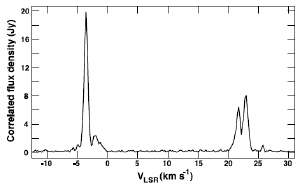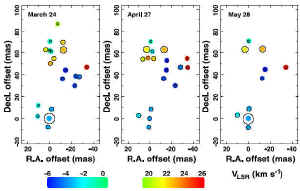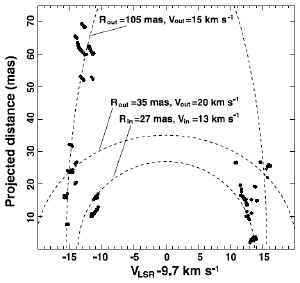IRC +10011 (= CIT 3)
-- An OH/IR star showing small bipolar outflow in IR
and H2O masers
Individual observations
 | SiO,v=1,J=2-1,1-0 and v=2,J=1-0
masers in IRC+10011 were mapped using
VLBA. The masers are located along a ring shape, indicating tangential masers. The v=1,2-1maser ring radius was larger than that of
v=1,1-0. They argue that ro-vibrational line overlap
with H2O lines could be responsible for this abnormal size relation.
(from Soria-Ruiz et al., 2004A&A...426..131S) |
 | A physical model was suggested to explain the
small bipolar outflow found by NIR imaging in the
central ~0.1" region of the OH/IR star IRC +10011 ( = CIT3). The outflow may
have a lifetime of ~ 200 yr.
(from Vinkovic et al., 2004MNRAS.352..852V) |
 | VLBA map of 29SiO maser was made to
IRC+10011. A complete ring distribution of maser spots was found (radius of
13.5mas). They concluded that this maser region lies between that of SiO,v=1,1-0 and 2-1. Vlrs = 9.2km/s. (from Soria-Ruiz et al., 2005A&A...432L..39S) |
 | The H2O maser spots in WX Psc =
IRC 10011 were mapped using VERA. The maser spots are distributed in two groups in N-S direction and are interpreted as
bipolar outflow in pole-on angle. They estimated a
Vexp = 16 km/s and dynamical age of ~300 years. Vlsr = 10km/s.
distribution region size is 100 mas x 80mas. (from Inomata et al.,
2007PASJ...59..799I)
(figure: left -- H2O maser line; middle -- H2O maser
spots distribution; right -- projected distance - radial velocity diagram of H2O
maser spots.)
   |
|
![]()